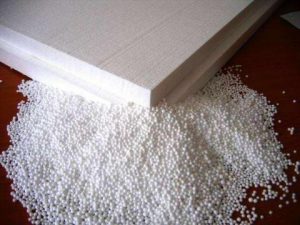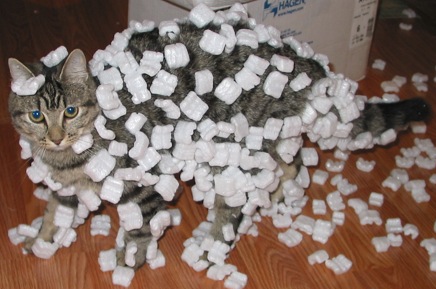The first time I mistakenly left a styrofoam board lying around, my cats took it for a scratching board. They scratched and scratched until small pieces of styrofoam were flying in the air. A visitor would have thought it was snowing inside our house! They made such a mess that I swore to myself never again to leave styrofoam and cats together unattended, ever! In reality, the mess created is the least of the problems when it comes to styrofoam and cats. The biggest problem is if it so happened that your cat ate styrofoam!
 Why Is Styrofoam Irresistible to Cats?
Why Is Styrofoam Irresistible to Cats?
Styrofoam is one of those non-food items that some cats just love to eat! It ranks up there together with plastics, rubber bands and strings. The smell and texture of the material may appeal to the cat’s senses. Little pieces of styrofoam floating in the air, usually those little spheres or peanut shaped styrofoam used as packaging material, may be taken as prey by an imaginative cat. More commonly, styrofoam containers used to pack food and drinks have the residual smell and taste of the food items they contained such that a cat, no matter how self-disciplined, may not be able to resist the temptation to eat them!
Styrofoam Is A Choking Hazard
Choking is the first potential nightmare when a cat ate styrofoam. Small pieces of this material have the tendency to stick to the insides of the mouth and throat that when eaten in sufficient amounts may block the passageway of air. So if you catch your cat in the act of eating styrofoam, manually remove these from her mouth immediately. If you were too late and she swallowed some already, then the next course of action depends on how much you think she ate. If these are a few small pieces, you can use a wait-and-see approach as long as you are always available to keep an eye on your cat and to check her litterbox every time she uses it. Do not try to induce vomiting at home without the consent and instruction of your veterinarian.
Styrofoam Blocks The Gut 
Another major concern if a cat ate styrofoam is foreign body obstruction in the gastrointestinal tract (GIT), or the gut. This may happen when your cat has eaten a large amount of styrofoam. If you saw your cat eat a lot of styrofoam or just suspected her of doing so, don’t delay anything. Take her to her veterinarian immediately! Signs of gut blockage are diarrhoea (partial blockage) or constipation (full blockage). Also there is vomiting, loss of interest in food, water and play and her belly will be painful to touch.
The danger with GIT obstruction is that when food cannot move down the intestines because of the mass of styrofoam blocking its path , it rots inside the gut. This causes harmful bacteria in the gut to flourish and later on cause parts of the stomach or intestines to die. This results in bad bacteria entering the blood or rupture of these organs. Either way, these are both serious life threatening conditions. Your veterinarian, upon performing a physical examination of your cat and doing the needed procedures like taking x-rays and running blood tests, may need to perform a surgical operation to remove the styrofoam from inside the gut.
Chemicals in Styrofoam May Be Poisonous and Cancer-causing
The third concern about a cat eating styrofoam is its potential as a toxin (poison) and as a carcinogen (a substance capable of causing cancer in living tissue). While styrofoam is not considered acutely toxic when eaten, it is still a wise move to have your cat’s liver and kidney functions tested by the veterinarian to rule out any harm done to these organs during your cat’s styrofoam-eating adventure. Carcinogenic effect may be due to long-term cumulative exposure so make sure your cat is not constantly eating styrofoam even if she passes them out without incident.

Don’t Let Kitty Get Her Paws on Styrofoam!
We cannot tell a cat “do not do this because this is what will happen if you do”. Therefore, the best way to avoid trouble with styrofoam is to completely deny your cat access to them. Throw away any packaging or containers you do not intend to reuse or recycle in secured bins immediately. Otherwise, keep them in your house in a room where your cat cannot get to them. Also make sure there are no exposed styrofoam insulation materials anywhere in your home. Refrain, if possible, from using ornaments made of styrofoam. Go over your home, check and cat-proof it because keeping your pet safe is definitely better than being sorry later.
You might also be interested in:
My Cat Ate Paper
 Why Is Styrofoam Irresistible to Cats?
Why Is Styrofoam Irresistible to Cats?


